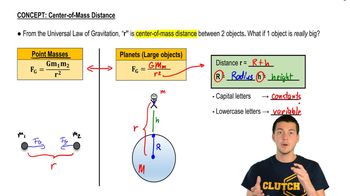Here are the essential concepts you must grasp in order to answer the question correctly.
Center of Mass
The center of mass is the point at which the mass of a system is concentrated and can be considered to act. For a system of particles, it is calculated as the weighted average of their positions, taking into account their masses. In this scenario, the center of mass is crucial for determining the balance point of the two balls connected by the rod.
Recommended video:
Mass and Distance Relationship
The relationship between mass and distance from the center of mass is fundamental in physics. The position of the center of mass is influenced by the masses of the objects and their distances from it. In this problem, the distance of each ball from the center of mass helps to establish a balance equation that can be used to find the unknown mass.
Recommended video:
Equilibrium Condition
In a system in equilibrium, the sum of the moments (torques) about any point must be zero. This principle allows us to set up an equation based on the distances and masses involved. For the two balls connected by a rod, the equilibrium condition will help us solve for the unknown mass by ensuring that the moments created by each mass around the center of mass are equal.
Recommended video:
 Verified step by step guidance
Verified step by step guidance


